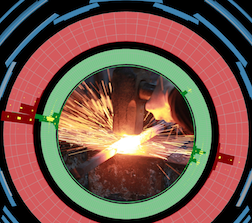Speaker
Description
The idea that dark matter forms part of a larger dark sector is very intriguing, given the high degree of complexity of the visible sector. In this talk, we discuss lepton jets as a promising signature of an extended dark sector. As a simple toy model, we consider an O(GeV) DM fermion coupled to a new U(1)′ gauge boson (dark photon) with a mass of order GeV and kinetically mixed with the Standard Model photon. Dark matter production at the LHC in this model is typically accompanied by collinear radiation of dark photons whose decay products can form lepton jets. We analyze the dynamics of collinear dark photon emission both analytically and numerically. In particular, we derive the dark photon energy spectrum using recursive analytic expressions, using Monte Carlo simulations in Pythia, and using an inverse Mellin transform to obtain the spectrum from its moments. In the second part of the talk, we simulate the expected lepton jet signatures from radiating dark matter at the LHC, carefully taking into account the various dark photon decay modes and allowing for both prompt and displaced decays. Using these simulations, we recast two existing ATLAS lepton jet searches to significantly restrict the parameter space of extended dark sector models, and we compute the expected sensitivity of future LHC searches.
Summary
In summary, we have studied the possibility of revealing the properties of a
dark sector of particle physics by using final state radiation from dark matter
produced at the LHC. The characteristic experimental signature of this process
is a pair of lepton jets. While our conclusions apply to a very large class of
extended dark sector models, we have worked in the framework of a toy model
where fermionic dark matter particles X are charged under a new dark
sector gauge group U(1)' and coupled to the SM through a heavy mediator.
When DM particles are pair-produced at the LHC via this heavy mediator,
they can radiate several light U(1)' gauge bosons A' (dark photons)
which subsequently decay to light SM particles (electrons, muons, mesons)
through a small kinetic mixing with the SM photon. Due to the
required smallness of the kinetic mixing, the A' decay length can be
macroscopic. We emphasize that our results for this toy model are easily
generalized to any model with light dark sector particles charged under a new
gauge interaction. We also remind the reader that, in order to account for all
of the DM in the Universe, X must be produced non-thermally, as for
instance in asymmetric DM scenarios.
We have first developed two analytic treatments of dark photon radiation: in
the first one, we use recursive expressions for the A' and X
energy distributions, while in the second one, we compute the moments of these
distributions fully analytically and then apply an inverse Mellin transform to
obtain the distributions themselves. We have compared our analytic
calculations with Monte Carlo simulations in Pythia, finding excellent
agreement.
In the second part of the paper, we have extended these Monte Carlo simulations
by a simplified description of the ATLAS detector that allows us to recast the
existing ATLAS searches for prompt and displaced lepton jets into powerful
limits on the DM pair production cross section and the dark photon parameters
in radiating DM models. Our limits on the X pair production cross
section range down to O(10 fb), depending on the X mass and
lifetime, the U(1)' gauge coupling, and the mass of X. Regarding the
A' properties, we find that LHC searches for radiating DM can probe a
region in the A' mass and kinetic mixing parameter space that has been inaccessible to low
energy dark photon searches so far. Of
course, these limits are subject to the condition that DM particles with large
coupling to dark photons can be
pair-produced at the LHC in significant numbers.
Looking into the future, we have also shown that LHC limits will significantly
improve in Run 2 at 13 TeV center of mass energy. It is worth emphasizing here
that our simplified 13 TeV analyses are still a far cry from what a full
experimental search can achieve. Most importantly, with a more detailed
detector simulation and data-driven background estimation methods, it will be
possible to include not only muonic lepton jets, but also A' decays
to electrons and hadrons.
To conclude, we have shown that lepton jets are an interesting and powerful
tool to elucidate the dynamics of the dark matter sector. Together with searches
for hadronic jets with non-standard properties, they will be essential in
the hunt for dark matter at Run~2 of the LHC and might well be the first
to find a positive signal.
